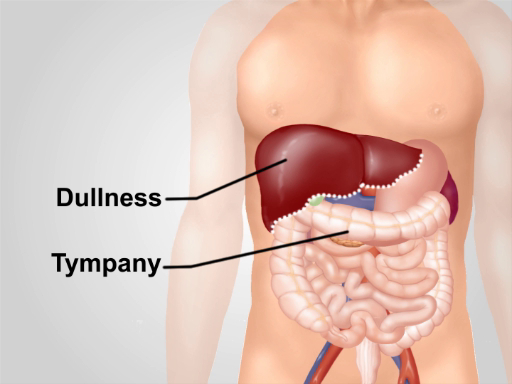腹部の試験 II: パーカッション
English
Share
Overview
ソース: アレキサンダー Goldfarb、MD、助教医学部ベス イスラエス ディーコネス メディカル センター、マサチューセッツ州
医療のパーカッションは、体壁で軽くたたくことによって誘発される音の間のピッチの違いに基づいています。タップへの聴覚応答は容易体壁が振動して基になる臓器によって影響されます、ストロークと体壁の状態の強度に依存します。3 つの主要な医療のパーカッションがある: 共鳴 (肺で聞いた)、tympany (空気で満たされた腸のループで聞いて)、くすみ (流体または固体器官で聞いた)。Tympany または共鳴対くすみの間のコントラストとサイズ決定器官および固まりのマージンだけでなく流体蓄積の識別と統合の分野のことができます。パーカッションのまま物理的な診断の複雑な部分以来、200 年以上前、全国初、肺や腹部の検査で特に便利です。
パーカッションに従う目視検査と聴診、腹部の検査の一環として。審査官はべきである 9 つの腹部領域 (心窩部地域、右季肋領域、左季肋部、臍領域、右腰部、左腰部、下腹地域、右鼠径部および左鼠径部) のそれぞれの上最初打診。打楽器によって誘発される優しさが異常と腹膜の炎症が疑われるべきです。腹部の壁に最も近い空気で満たされた腸のループを配置すると腹腔内のほとんどの部分でパーカッションは主に鼓膜の音を引き出します。くすみの大きい区域の存在は、organomegaly、腹部の固まり、または流体の評価を促すべきです。
額と腹部ガスの分布を評価するとともに腹部の試験は打楽器による肝臓と脾臓のサイズの推定を含める必要があります。肝臓と脾臓は肋骨で覆われて、審査官は同様下の前胸部に打診する必要があります。通常、1 つは右前胸部、肝臓を介してのパーカッションの鈍い音と胃の空気の泡を左前胸部の打楽器と (図 1) 結腸脾彎曲部の鼓膜の音を聞くことを期待します。

図 1。腹部領域に通常打楽器のノート。右下の前胸部で肝臓にくすみの区を除いて tympany は地域の支配的な音。
Procedure
Applications and Summary
Despite rapid advances in imaging techniques, abdominal percussion remains an essential part of a physical examination. Correct percussion technique is critical for this method to be effective. The percussion strike should be kept the same over the entire abdomen. All the information obtained during the patient’s interview and full physical examination, and a good knowledge of differential diagnoses of each pathological sign is essential for proper interpretation of any findings. For example, a false increase of liver span on percussion can result from right lung consolidation and/or a pleural effusion. One should also be aware of the limitation of the method and the sensitivity of each diagnostic maneuver. While percussion is only moderately accurate in detecting hepato-and splenomegaly, abnormal findings should prompt further clinical evaluation.
Transcript
Percussion is a critical part of the abdominal examination; therefore, learning the correct technique is essential for any physician aiming to make quick, yet accurate diagnosis of gastrointestinal pathologies. As you might know, medical percussion is based on the difference in pitch between the sounds elicited by tapping on the body wall. The sounds produced during abdominal percussion can help detect pathologies like organomegaly, intra-abdominal masses, and fluid accumulation. This video will illustrate the major anatomical areas to be percussed during an abdominal exam, and the steps and findings of this procedure.
First, let’s talk about the expected abdominal percussion sounds and their interpretations. As the air-filled bowel loops are positioned in the closest proximity to the abdominal wall, percussion over most parts of the abdominal cavity elicits a predominantly tympanic sound… Notice that this sound is relatively long, high pitched, and loud.
Percussion over dense organ tissues, like the spleen or the liver, produces a dull sound… Therefore, the contrast between dullness versus tympany allows for determination of the margins of these organs and thus help in detection of conditions like hepatomegaly or splenomegaly. Dull sounds are also produced on percussing areas filled with fluid and feces. Therefore, by percussing one can predict the cause of protuberant abdomen, which helps in diagnosis of conditions like ascites.
With this background in mind, let’s review a detailed step-wise procedure for abdominal percussion. Explain the procedure to the patient and obtain their consent before starting with the exam. Drape the patient appropriately to expose the torso area and perform light percussion over each of the nine abdominal regions.
Listen to the intensity, pitch, and duration of the percussion note. Normally, tympanic sound produced by air in the bowel loops will be heard… As you percuss, watch the patient’s face for any signs of discomfort. Ask the patient if they are experiencing any tenderness. Tenderness on percussion is abnormal and can indicate peritoneal inflammation.
After abdominal area, percuss the lower anterior chest, above the costal margins. Dull sound on the right, over the liver is expected… On the left, one should hear tympany over the gastric air bubble and the splenic flexure of the colon… Following that, move to the area of pubic symphysis. Again, this should yield a tympanic sound…dullness indicates enlarged uterus or distended bladder.
Next step is to determine the liver span. Start by locating the right midclavicular line. Starting in the area of tympany below the umbilicus, lightly percuss in the right midclavicular line moving upwards… Make a mark where the tympany changes to dullness with a skin pencil. This is the lower border of the liver. Then, starting at the nipple line, again percuss in the right midclavicular line moving downwards. Note the point where the resonant sound changes to dullness…and mark it with a skin pencil. This is the upper border of the liver. Measure the distance between upper and lower border in centimeters. The liver span is normally 6-12 cm.
Following the liver span measurement, percuss to detect splenomegaly. The two maneuvers for this include Percussion of the Traube’s space and the Castell’s method. For percussion of the Traube’s space, make sure that the patient’s left arm is slightly abducted, and percuss from the medial to lateral border of this area. Overall dullness on percussion, or reduction of the area of tympany can indicate spleen enlargement. For the Castell’s method, percuss in the anterior axillary line in the lower intercostal space. Ask the patient to take a deep breath and percuss again. Normally, the percussion tone is tympanic on both inspiration and expiration. If the percussion note is dull, or becomes dull on inspiration, splenomegaly should be suspected.
Lastly, percussion is helpful to detect the cause of a protuberant abdomen. If the patient has a protuberant abdomen, percuss from the umbilicus in a lateral direction and with the skin pencil make a mark of the point where the tympanic sound changes to dullness. Then, ask the patient to roll on their side and repeat the percussion starting from the top and make a second mark when the tympanic sound changes to dull. If abdominal fluid were present, the level of dullness on the side would shift upwards toward the umbilicus, compared to the level of dullness in supine position.
You’ve just watched JoVE’s video on percussion to be performed during an abdominal exam. You should now know the important abdominal percussion steps and understand differential diagnoses that can be performed by proper interpretation of percussion findings. As always, thanks for watching!
